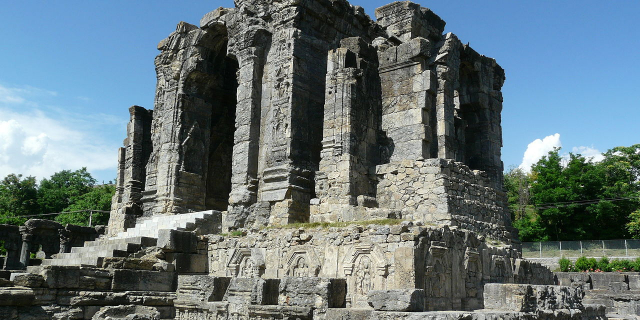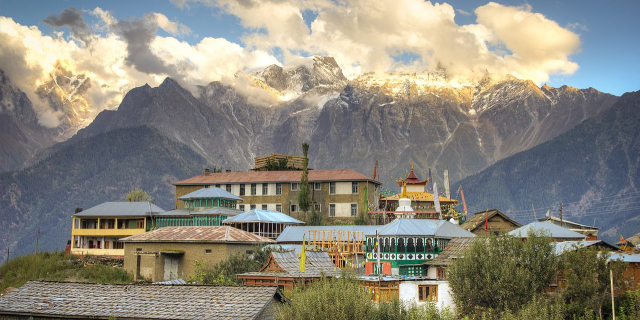Spiti (pronounced as Piti in Bhoti language) is a high-altitude region of the Himalayas, located in the north-eastern part of the northern Indian state of Himachal Pradesh. The name "Spiti" means "The middle land", i.e. the land between Tibet and India. Spiti incorporates mainly the valley of the Spiti River, and the valleys of several rivers that feed into the Spiti River. Some of the prominent side-valleys in Spiti are the Pin valley and the Lingti valley. Spiti is bordered on the east by Tibet, on the north by Ladakh, on the west and southwest by Lahaul, on the south by Kullu, and on the southeast by Kinnaur. Spiti has a cold desert environment. The valley and its surrounding regions are among the least populated regions of India. The Bhoti-speaking local population follows Tibetan Buddhism.
Traditionally, agriculture was for subsistence, but has shifted to cash crops in the past few decades. Spiti is a popular destinatio...Read more
Spiti (pronounced as Piti in Bhoti language) is a high-altitude region of the Himalayas, located in the north-eastern part of the northern Indian state of Himachal Pradesh. The name "Spiti" means "The middle land", i.e. the land between Tibet and India. Spiti incorporates mainly the valley of the Spiti River, and the valleys of several rivers that feed into the Spiti River. Some of the prominent side-valleys in Spiti are the Pin valley and the Lingti valley. Spiti is bordered on the east by Tibet, on the north by Ladakh, on the west and southwest by Lahaul, on the south by Kullu, and on the southeast by Kinnaur. Spiti has a cold desert environment. The valley and its surrounding regions are among the least populated regions of India. The Bhoti-speaking local population follows Tibetan Buddhism.
Traditionally, agriculture was for subsistence, but has shifted to cash crops in the past few decades. Spiti is a popular destination for photography, homestay tourism, and adventure tourism of various kinds, including winter sports.
 Tabo Monastery viewed from monks' cavesPre-historical period
Tabo Monastery viewed from monks' cavesPre-historical period
There is evidence of very early human habitation in the Spiti valley, primarily through its rich heritage of pre-Buddhist rock art. Spiti's rock art is thought to have been produced over a wide period of time, with the earliest examples dating back nearly 3,000 years. Spiti's rock art has been categorized, based on differences of the designs depicted, into the following periods: the Late Bronze Age (c.1500–800 BCE), the early Iron Age (c.800–500 BCE), the Iron Age (c.500–100 BCE), the Protohistoric period (100 BCE–650 CE), Early Historic Period (650–1000 CE), Vestigial Period (1000–1300 CE), and the Late Historical Period (post-1300 CE).[1]
The period from the mid-7th century to the early 19th centuryThere is some evidence to show that Spiti was a part of the western Tibetan kingdom of Zhang Zhung until the mid-7th century CE.[1][2] Buddhism first came to Spiti likely through the Second Diffusion of Buddhism into Tibet, and it was at this time that the Tabo monastery was built (996 CE).[3] In the 10th century, Spiti was part of the kingdom of Ngari Khorsum established by Kyide Nyimagon of the Tibetan royal lineage.
After Kyide Nyimagon's death, Zanskar and Spiti were given to his youngest son Detsukgon, while the eldest son Lhachen Palgyigon became the King of Ladakh. After that, the history of Spiti was linked with the history of Ladakh for a long time. Local rulers had the title of Nonos. They were either descendants of a native family of Spiti or chiefs sent to look after the affairs of Spiti by the rulers of Ladakh. This region became autonomous whenever the rulers of Ladakh were weak. However the rulers of Spiti periodically sent tributes to Ladakh, Chamba and Kullu.[4]
Spiti became practically free after the Tibet–Ladakh–Mughal War of 1679–1683. This prompted Man Singh, Raja of Kullu, to invade Spiti and establish a loose control over this principality. Later on, in the 18th century, control once again passed back to Ladakh. An official was sent from Leh as Governor, but he usually went away after the harvest time, leaving the local administration in the hands of the Wazir or Nono. There was a headman for a group of villages for day-to-day administrative affairs.[4] Spiti briefly came under the Dogra rule (as part of the Sikh Empire) between 1842 and 1846, after which it was annexed to the British Empire.
Colonial periodUnder the Treaty of Amritsar (1846), Spiti alongside Lahaul was split off from the erstwhile kingdom of Ladakh, and came under direct British administration.[5] Mansukh Das, hereditary Wazir of Bushahr, was entrusted with the local administration of this region from 1846 to 1848. The Wazir had to pay the British revenue of only Rs. 700 annually for the whole of Spiti. In 1849, Spiti came directly under the control of the Assistant Commissioner, Kooloo (Kullu).[6]: 132 Kullu was a sub-division of Kangra district, Punjab. Now, the Nono of Kyuling in Spiti was made incharge of collecting and submitting revenues from Spiti to the British. In 1941, Spiti was made part of the Lahaul tehsil (sub-division) of Kullu district, with its headquarters at Keylong.
Post-Independence periodAfter the formation of Lahaul & Spiti into a district in 1960, Spiti was formed into a sub-division with its headquarter at Kaza.[7] Lahaul and Spiti district was merged with Himachal Pradesh on 1 November 1966 on enactment of the Punjab Reorganisation Act.






























Add new comment